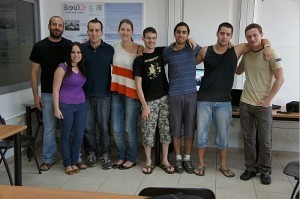Your book – anyway you want it
 A group of students from the Faculty of Computer Science at the Technion have created an application that “writes a book on its own”, in any topic specified by the user
A group of students from the Faculty of Computer Science at the Technion have created an application that “writes a book on its own”, in any topic specified by the user
It allows anyone to prepare a guide book just moments before going on vacation or touring museums
“The idea for the book was brought up as part of the course supervised by Prof. Yossi Gil,” explains Michal Nir, one of the eight students who participated in the project. “We got an algorithm that was developed by one of the department’s faculty members and the team was asked to find an application for it. One of the course requirements was to relate to everything as if it was a start-up project and not as an academic assignment. Consequently, it was important for us to present an attractive product, with a catchy name, whose design was eye-pleasing and user-friendly plus one that met an actual need.”
During the semester the group worked intensively on developing Bookit! and today, it is their product, available on the website developed by the students (http://tiny.cc/bookitnow). In order to create a book, the user is required to enter key words related to the subject he or she has chosen – for instance, travel Spain or art Picasso – and in a short while (a matter of minutes, at most) the book is ready. “The site was built using advanced technology and is meant to be run mainly on the Firefox and Chrome browsers,” adds Michal.
“As noted, there is the basic algorithm we got at the beginning of the year,” says student Benjamin Kamfer, “but we had to work on it and develop it to meet our specific needs. Every time we ran into a problem, we improved it in order to solve the problem.
“At this point in time, the algorithm searches Wikipedia for the requested variables and builds a type of “relevance ladder” of different occurrences, from which it creates the book. In other words, it is not a blind search for these values but a very smart search, which analyzes the relevance of the existing material on the Net to the user-entered specifications.”
“You can, of course, expand the method for searching on the Net, but this requires additional work,” explains Saar Gross, “and for us it was very important to present a finished product and not something half way through development. We, therefore, limited ourselves to working with Wikipedia, and as you can see by the results, it works very well, also in terms of locating content as well as in terms of the book’s graphic design.
“We definitely do not intend stopping here, but rather will continue to develop the algorithm and the site by improving the existing system capabilities and adding new features.”
Above (Right to left): Vladimir Rudenko, Roee Migdal, Itamar Azolai, Alon Morgenstern, Inbal Serchuk, Saar Gross, Michal Nir, Benjamin Kamper


